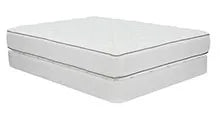1 Sided vs. 2 Sided Mattress
One-sided mattresses are built from the ground up to provide ideal comfort at the surface. Two-sided mattresses are built from the core out, usually, an innerspring system surrounded by padding. So, both sides of the mattress are the same.


In 2007, most manufacturers shifted their production to one-sided mattresses. While some manufacturers still produce double-sided mattresses, they're often sold at higher prices. They usually have to charge more due to lower demand.
There's no significant difference in durability between the two types. One-sided mattresses allow manufacturers to build the mattress from the ground up to maximize its potential comfort. Learn more about Mattress Durability in this article.
Two Isn't Always Better Than One
Today, one-sided mattresses dominate the industry and are most common in mattress stores. Most consumers appreciate not having to worry about flipping when they purchase their new mattresses. But some consumers miss the two-sided mattresses. They feel like they're not getting as much bang for their buck when they buy a one-sided mattress.
In reality, one-sided mattresses are the highest quality mattresses. They allow manufacturers to start with a core and add several comfort layers from the bottom up. With double-sided mattresses, each side only has padding from the center to the surface.
One-sided mattresses of the same thickness have twice the amount of comfort materials on the sleeping surface. Due to this, the lifespan or life of the mattress will be just as long with one side. It should wear out at a similar rate as a mattress with comfort materials split between two surfaces, as seen in flippable mattresses where sleepers can choose a side based on their comfort preferences. Learn more about this and other mattress myths in our article 10 Mattress Myths You Shouldn't Believe.
Being able to experience the benefits of sleeping on twice the amount of comfort materials with a one-sided bed is what makes it the best mattress and breaks the tie. It’s also more convenient, not to have to flip your mattress regularly. For these reasons, one-sided mattresses are now the industry standard.
In fact, since the mattress industry moved to a one-sided design, warranty claims have become less prevalent. One-sided mattresses generally need little maintenance. But the industry does recommend rotating them from head to foot about once every four months. This ensures even wear across the surface of the mattress for an extended comfort life.
What's Inside?
One-sided mattresses feature a base layer with comfort materials stacked on top. These can be foam, more coils, latex, or natural materials such as cotton and wool. In double-sided mattresses, a supportive coil system is in the center, with comfort layers on either side. There are memory foam, natural latex, and hybrid mattresses as well as innerspring mattress available as both one and two-sided mattresses.
Where Can I Buy a Two-Sided Mattress?
It can be a bit difficult to find a one-sided mattress these days, as many companies switched over to one-sided completely. However, there are a few brands that still make flippable mattresses of high quality. US-Mattress sells a range of double-sided mattresses from Serta, Restonic, and Spring Air.
Read more about a popular two-sided mattress in our Layla mattress review.
The ZenHaven is also a highly regarded flippable mattress. Saatva makes a flippable mattress that's particularly great for kids, called the Saatva Youth.
What is a No-Flip Mattress
Also known as "one-sided mattresses," no-flip mattresses are built from the ground up and aren't reversible. Flippable mattresses have a supportive core with comfort materials on both sides. But no-flip mattresses start with the supportive layer on the bottom and stack the comfort layers on top. These mattresses don't need to be flipped and only have one sleeping surface. Learn more in our article Mattress Types: Explained.

One-Sided Technology
Years ago, most mattresses had two sides and you had to flip and rotate them. But since Simmons introduced the one-sided mattress in 2000, two-sided mattresses have been phasing out. One-sided mattresses don't need to be flipped, though rotating is still a good idea for some models.
Why the Change?
Traditional innerspring mattresses are built around a central coil system. No-flip mattresses feature a coil system base with layers of comfort materials stacked on top. In a two-sided mattress, the comfort layers are on both sides of the coil system. In a no-flip, a one-sided mattress can have twice as many comfort layers stacked on top of the coil system base. This allows for more potential to create a more comfortable mattress. Also, twice as many comfort materials mean that the single sleeping surface should last about twice as long.
Benefits
There are many benefits to no-flip mattresses. Of course, a great benefit is not having to flip a heavy mattress to ensure uniform wear. Even better, you'll have twice as many comfort layers working to relieve pressure on your body and reduce motion transfer. This is especially valuable for those who share a bed with an active sleeper.
For those concerned that a no-flip mattress won't last as long as a double-sided mattress, you need only look at the warranty. You'll see those one-sided mattresses are guaranteed to last just as long (if not longer). In fact, one-sided mattresses are historically less likely to have warranty claims filed against them than two-sided mattresses.
While the vast majority of mattresses you'll find on US-Mattress are no-flip, we do still carry a number of high-quality two-sided mattresses. If you're not certain which type of mattress is best for you, you can call 1-800-455-1052 to speak with a friendly mattress expert. They can help you make an informed and confident decision.
Flipping and Rotating Your Mattress

Taking Care of Your Mattress
When you buy a new mattress, you expect to get your money’s worth and for it to last a long time. The average mattress should have a lifespan of 7 to 10 years. To make sure your mattress lasts as long as possible, there are some things you can do to help yourself out.
To avoid wear and tear, you should rotate your mattress so that you are laying on a fresh piece of the mattress. To rotate your mattress, simply turn in 180 so the foot of the bed becomes the head of the bed and vice versa. Most mattress companies produce mattresses that are one-sided and only need to be rotated.
If you sleep on a double-sided mattress, you will have to flip your mattress on occasion. Double-sided mattresses allow you to sleep on either side of the mattress. Be warned, if you flip a mattress that is not designed to be flipped, it will cause extreme discomfort. Most one-sided mattresses are better overall than flippable mattresses.
When to Flip
You should flip your mattress to make sure one side of the bed does not get too worn down. Flipping your mattress prevents indents and sagging. For best results, your mattress needs to be flipped once every six months.
One-Sided Mattress
As mentioned before, most mattress manufacturers make new mattresses that are one-sided and are not made to be flipped. They are constructed in such a way that they provide specific layers of comfort to give you a good night's sleep.
Modern mattresses are made up of comfort layers. The bottom layer is the thick support layer, this is typically made of dense foam or metal springs (sometimes both) making the support core. The upper layer is made up of layers of foam or other materials to cover various firmness levels and densities, this is known as the comfort system. The top layer is the cover, made from various materials to form the mattress topper provides additional comfort to the sleeper.
When to Rotate
The frequency of mattress rotation depends on the material of the mattress. A memory foam mattress or a latex mattress should be rotated 1-2 times per year. The same rule applies for a newer innerspring mattress, while an older mattress made from innerspring should be rotated 2-5 times a year. A hybrid mattress should be rotated every 3 to 6 months.
Whatever your schedule is, keep it consistent. Not having an organized plan could result in a failure to rotate at the right time could cause more rapid wear down of the life of your mattress.
Be careful that if you have a mattress with a zoned comfort system, it should never be rotated. This type of mattress will have support in specific places. If you rotate a zoned comfort mattress, you will be sleeping on spots that are not built to be slept on, causing discomfort.
ConclusionRotating or flipping your mattress periodically will help extend its lifespan. Remember that the best mattresses are typically one-sided. Providing proper mattress care to a new bed will provide better sleep because you will spend more time sleeping in comfort, this will help avoid back pain or other discomforts. |
About the Author, Dave Higgins, Mattress Expert

Dave Higgins, Mattress Expert
Dave has worked in the furniture business, focusing on mattresses, for several years. His focus on mattress industry trends and developments has led to a deeper understanding of how people sleep and how they perceive comfort.


